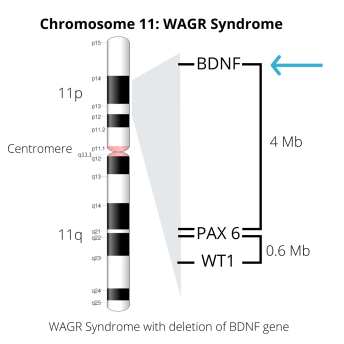Haploinsufficiency of the BDNF Gene is Associated with Reduced Pain Sensitivity
BDNF stands for Brain-Derived Neurotrophic Factor. BDNF is a protein found in the brain and in the spinal cord. BDNF helps with the survival of neurons (nerve cells) and the development of new ones. BDNF also helps neurons to make synapses, which are communication connections.
The gene that provides instructions to the body for making this protein is called the BDNF gene.
The precise effects of BDNF are not all known, but are likely specific to the different types of neurons it acts on. BDNF is thought to be involved in:
WAGR syndrome is caused by a missing segment of mulitiple genes on the short "p" arm of chromosome 11, around area 13 (indicated as 11p13). The length of the missing segment varies from one person with WAGR syndrome to another. The BDNF gene is located at 11p14.1.
A 2006 study at the National Institutes of Health (USA) found that 50 percent of subjects with WAGR syndrome were missing the BDNF gene.

More research is needed to fully answer this question. Currently, what is known is that BDNF gene deletion affects:
Individuals with WAGR syndrome who are overweight/obese, especially those who have gained weight early in life, are more likely to have the BDNF gene deletion. This suggests that the lack of BDNF might be playing a role in eating habits and metabolism, because BDNF should signal the brain that the stomach is full and the body has obtained enough energy. But if BDNF levels are too low, these signals never reach the brain. This may be why some people with WAGR and BDNF deletion do not seem to experience feeling full after eating. This lack of satiety may cause them to eat extremely large amounts of food, to eat rapidly, to constantly “seek” food, and to eat whatever they can find, including spoiled foods or garbage.
Individuals with WAGR syndrome and BDNF gene deletion score lower in tests of intelligence and adaptive behavior and higher in tests of social impairment than individuals without the deletion.
Studies in both animals and humans suggest that BDNF plays a role in nociception, or the perception of pain. People with WAGR syndrome and BDNF deletion may have an increased tolerance for pain. In some cases, they may not react as expected (grimace, cry, or complain) with minor or even with moderate injury or illness.


More research is needed to discover safe and effective treatment for BDNF gene deletion. Unfortunately, early experiments in animals that involved increasing the level of BDNF protein showed either no effect, or mild effects with severe side effects. Currently, no medications or dietary supplements have been proven to increase BDNF levels effectively and safely.
Individuals with WAGR syndrome and BDNF gene deletion benefit from referral to a dietician
Since people with WAGR syndrome and BDNF gene deletion have an increased tolerance for pain and decreased expression of pain, parents and physicians should be alert to other signs of injury or illness
Studies have shown that regular exercise leads to the release of proteins and other molecules from muscle, fat, and liver tissue that can affect levels of BDNF. While there are currently no studies on the effects of exercise in patients with BDNF gene deletion, regular exercise in typical people has been shown to help with anxiety and depression, and with learning and memory formation.
Children with WAGR syndrome and BDNF gene deletion benefit from Early Intervention Services and Special Education. Particular emphasis on maximizing communication and social skills may also be helpful.
Sign up for News & Events
COPYRIGHT© 2025 IWSA / International WAGR Syndrome Association
